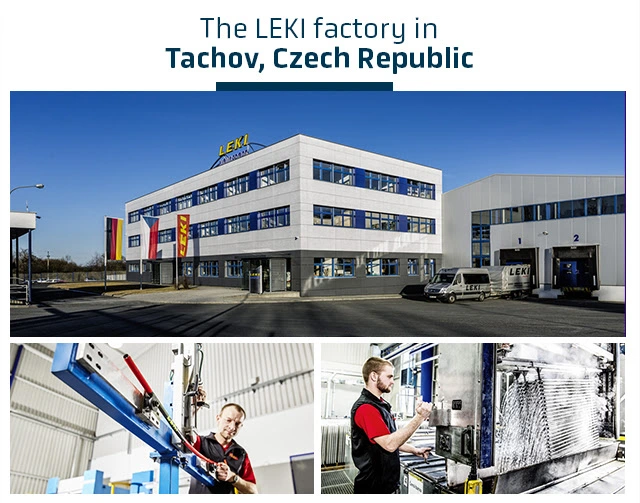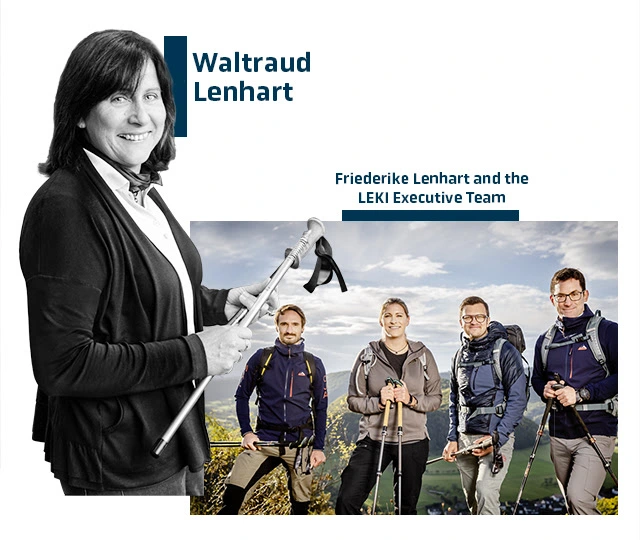In 1948, in the small village of Kirchheim Teck, Germany, Karl Lenhart, an aircraft mechanic by trade, took his precision machinery skills and crafted wooden letters to be used to make signs for the local bakeries and butcher shops. Karl’s passion for innovation, attention to detail, and impeccable craftsmanship started him down a path that would eventually lead to the creation of one of the most respected companies in the outdoor industry.
Karl was a passionate skier during the 1950s, and like all skiers of that time, Karl used ski poles made of bamboo. These poles had baskets made of metal and leather and the straps wore out quickly causing the baskets to fall off the poles. Karl saw the need for something better and decided it was time to improve traditional baskets that had been in use for decades.
Using his precision machinery, he constructed the first tip and basket system made from direct-injected plastics. Karl’s baskets included threads allowing them to be twisted on and off the pole tip when they needed replacing (this technology is still used on LEKI poles today). Before long, Karl was crafting injected plastic pole grips, and Karl found himself in the spare parts business.
With his experience in aircraft construction, Karl pushed the design envelope even further. Karl believed aluminum would be the perfect material for a pole shaft – light and durable. By 1963, Karl produced and sold the first aluminum poles made from alloys under the brand “Duraluminum.” Less than a decade later the brand name was changed to LEKI. The LE comes from the first two letters of Lenhart’s last name and the KI from the first two letters of Kirchheim, Germany where the company was founded and is still headquartered today!


During the 70s, Karl had revolutionized winter sports and began to take notice of mountaineers summiting the world’s highest peaks using ski poles. Many climbers had been using bamboo poles for mountaineering, but Karl recognized an opportunity to make adjustable climbing poles from aluminum. These lightweight and durable telescoping poles could be collapsed and stowed away when climbers needed to use ice tools and ropes. He worked closely with Reinhold Messner to create the first Makalu trekking pole. On May 8th, 1978, Reinhold Messner stood on top of Everest, the first person to ever summit without oxygen. While Reinhold didn’t need oxygen, he did need his LEKI poles!


In 1984, Karl Lenhart passed the torch to his son Klaus who had been working with LEKI as an engineer since his early 20s. Klaus become the General Manager of LEKI and shaped the foundation of the modern LEKI that we know today. He was the genius behind product innovation and more than 250 patents can be traced back to his ideas. His obsession with the product was legendary and his passion was relentless. Klaus could often be found sketching new design ideas on paper napkins while out to dinner.

In the 90s, LEKI was outgrowing production capacity in the factory in Germany. While many companies were moving production to the Far East, Klaus wanted to keep his hands on the product and control it down to its finest detail. He decided to return LEKI to the place of his ancestors – Bohemia. He envisioned the world’s most modern pole factory right in the heart of Europe and built a state-of-the-art production facility in Tachov, Czech Republic. The local production allowed LEKI to control its quality and generated flexibility and resilience in a challenging global market. Klaus was a unique combination of a product genius and a visionary entrepreneur at the same time.

April 12th, 2012 marked a dark day in the history of the company. The loss of Klaus in a tragic plane accident was a shock to his family, the company, and its many partners. Many suspected that without Klaus the company wouldn’t survive. Nobody could deny that the company and its structure were circled around its strong leader. In this moment of uncertainty, Klaus’s wife Waltraud stood up and took the helm of the company. Until that moment, Waltraud had looked after financials and administration at LEKI, always in the back and never in a public role. There were people inside and outside the company having doubts about the future, but she overcame them all and built a spectacular legacy.
Under Waltraud’s leadership, LEKI experienced the most intense period of growth in its history. Her formula of success was different compared to her predecessors. She was not the centerpiece of the new LEKI, she was the coach at the sideline and protector of LEKI’s values. Step by step she forged a strong and highly competent executive team. In silence, she prepared LEKI according to her own vision. It was obvious to her that LEKI needed to be independent and resilient and not depend on one person, especially not herself. In that regard, she was a visionary and genius, planting the seeds for a fruitful future prior to her untimely death in 2021. With Klaus and Waltraud’s children taking ownership, LEKI heads into its third generation as a family-owned business. The new generation stands firmly behind LEKI’s core values: Innovation, quality, enthusiasm, excellence, partnership, and responsibility.
Never a company to rest, LEKI is already focused on the future with upgrades to the factory to harness renewable energy sources and the development of sustainable products, like poles made from hemp that utilize responsible manufacturing methods.

Over the last 75 years, LEKI has become the leader in the design and development of poles for alpine and Nordic skiing, hiking, trail running, and Nordic Walking.
In 2023, LEKI’s mission is to make the best poles and gloves in the world for everybody. With more than 100 models of poles and 50 gloves in the annual collection, LEKI has come a long way since Klaus Lenhart carved his first wooden letters in Kirchheim 75 years ago.
LEKI will continue to thrive thanks in part to a ceaseless passion for excellence on one end and incredible customers on the other. To all that have been part of the journey, we thank you.
This is a guest post from a LEKI release.



